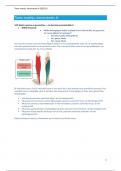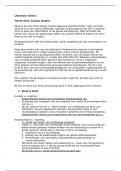PEOPLE IN GROUPS - COURSE 1.1
Problem 1: Head in the clouds
Problem definition
Why do men react differently on the bridges?
a. Why do the stories at the higher bridge had more sexual content?
b. Why did men on higher bridge called women more often than on lower bridge?
c. Relation between stress and sexual arousal
Learning Goals
1. Relation between (sexual) arousal and emotion (different theories of emotion)
2. Relation between arousal and the experience, behaviour, memory
3. Dutton & Aron, 1971
Arousal and emotion
Arousal is the state of being physiologically alert, awake, and attentive.
→ senses get heightened positive arousal → enhanced memory
Emotion is any conscious experience characterized by intense mental activity and a certain degree of
pleasure or displeasure; usually accompanied by certain physiological changes, as increased heartbeat
or respiration
- Caused by a stimulus
- Different emotions trigger different responses (lead to different behaviours) e.g. flight, fight
Emotions also affects later information processing
Positive emotions Negative emotions
- greater cognitive flexibility - focus more on detail
- broader focus, less detailed - anger → focus on obstacle
- fear → focus on likely outcomes
An emotion has two components
1. Undifferentiated state of physiological arousal
2. Cognitions that label the arousal
→ Physiologically similar arousals are associated with different emotions
,Theories of emotion
Common-sense perspective
Emotions arouse when we encounter a significant stimulus, and this encounter leads to bodily
changes that differ by emotion.
James-Lange theory (1884)
Emotions are caused by the perception of unique physiological changes, which are triggered by an
arousing stimulus. The emotion is the awareness of one´s bodily changes.
Criticism
The same physiological changes occur with different emotions.
Cannon-Bard theory (1927)
Compare with experiment 1
“Injection of epinephrine”
• a stimulus triggers a particular response in the brain (at the thalamus), which then causes both
physiological changes associated with an emotion, and the emotional experience itself
• Subcortical activity is necessary to process quite general physiological responses and induce
emotional experiences
Criticism
If different emotions are associated with comparable physiological responses, why do we have the
subjective impression that our bodies react quite different in different emotional states?
,Two-factor theory of emotion (Schachter and Singer theory)
Compare with experiment 2 “Injection of epinephrine” of Schachter and Singer (1962)
Emotional experience results from the interpretation (appraisal) of bodily responses in the context of
situational cues.
Emotions have two distinct components (they go usually hand-in-hand)
• First: Undifferentiated symptoms of physiological arousal
(racing heart, perspiration, rapid breathing, …)
• Then: Cognitive interpretation of the arousals´ source (causal attribution):
Cognitions label arousal and determine which emotion is experienced
People are including their environment, also reactions of people around.
When people are uncertain how they feel, they sometimes interpret their emotional state by
observing the behaviour of others, what might also lead to misattribution.
Misattribution of arousal
the process whereby people make a mistake in assuming what is causing them to feel aroused.
Physiological symptoms may be attributed to incorrect stimuli because many stimuli have similar
physiological symptoms.
Possible effects of misattribution of arousal
- Perceiving a potential partner as more attractive because of a heightened state of physiological
stress
- Aroused persons would dislike an unattractive confederate more than those without arousal
“Capilano Bridge Experiment”: misattribution through aroused state on high bridge
Criticism
- Aroused people also turn to events that preceded the physiological state for an explanation.
- Too intense physiological arousal leads to an aversive reaction to other peoples´ influence
, Excitation transfer theory (Zillmann, 1971)
Read “Love at First Fright”
Residual excitement from a previous arousing stimulus or situation may serve to intensify a later
emotional state (a former stimulus whose effects linger of time) e. g. sexual arousal, a workout
• The sympathetic nervous system does not terminate its arousal abruptly, it declines over a
period.
• In an emotion-provoking situation this residual excitement might be misinterpreted by the
individual to their current situation
• Whether excitation transfer appears, is dependent whether environmental cues of original
stimuli are readily apparent → excitation transfer is unlikely, if individual connects prior
source and residual state of excitement
→ can explain more aggressive behaviour than usual
“Capilano Bridge Experiment”: excitation transfer when men call woman in state of residual excitement
Problem 1: Head in the clouds
Problem definition
Why do men react differently on the bridges?
a. Why do the stories at the higher bridge had more sexual content?
b. Why did men on higher bridge called women more often than on lower bridge?
c. Relation between stress and sexual arousal
Learning Goals
1. Relation between (sexual) arousal and emotion (different theories of emotion)
2. Relation between arousal and the experience, behaviour, memory
3. Dutton & Aron, 1971
Arousal and emotion
Arousal is the state of being physiologically alert, awake, and attentive.
→ senses get heightened positive arousal → enhanced memory
Emotion is any conscious experience characterized by intense mental activity and a certain degree of
pleasure or displeasure; usually accompanied by certain physiological changes, as increased heartbeat
or respiration
- Caused by a stimulus
- Different emotions trigger different responses (lead to different behaviours) e.g. flight, fight
Emotions also affects later information processing
Positive emotions Negative emotions
- greater cognitive flexibility - focus more on detail
- broader focus, less detailed - anger → focus on obstacle
- fear → focus on likely outcomes
An emotion has two components
1. Undifferentiated state of physiological arousal
2. Cognitions that label the arousal
→ Physiologically similar arousals are associated with different emotions
,Theories of emotion
Common-sense perspective
Emotions arouse when we encounter a significant stimulus, and this encounter leads to bodily
changes that differ by emotion.
James-Lange theory (1884)
Emotions are caused by the perception of unique physiological changes, which are triggered by an
arousing stimulus. The emotion is the awareness of one´s bodily changes.
Criticism
The same physiological changes occur with different emotions.
Cannon-Bard theory (1927)
Compare with experiment 1
“Injection of epinephrine”
• a stimulus triggers a particular response in the brain (at the thalamus), which then causes both
physiological changes associated with an emotion, and the emotional experience itself
• Subcortical activity is necessary to process quite general physiological responses and induce
emotional experiences
Criticism
If different emotions are associated with comparable physiological responses, why do we have the
subjective impression that our bodies react quite different in different emotional states?
,Two-factor theory of emotion (Schachter and Singer theory)
Compare with experiment 2 “Injection of epinephrine” of Schachter and Singer (1962)
Emotional experience results from the interpretation (appraisal) of bodily responses in the context of
situational cues.
Emotions have two distinct components (they go usually hand-in-hand)
• First: Undifferentiated symptoms of physiological arousal
(racing heart, perspiration, rapid breathing, …)
• Then: Cognitive interpretation of the arousals´ source (causal attribution):
Cognitions label arousal and determine which emotion is experienced
People are including their environment, also reactions of people around.
When people are uncertain how they feel, they sometimes interpret their emotional state by
observing the behaviour of others, what might also lead to misattribution.
Misattribution of arousal
the process whereby people make a mistake in assuming what is causing them to feel aroused.
Physiological symptoms may be attributed to incorrect stimuli because many stimuli have similar
physiological symptoms.
Possible effects of misattribution of arousal
- Perceiving a potential partner as more attractive because of a heightened state of physiological
stress
- Aroused persons would dislike an unattractive confederate more than those without arousal
“Capilano Bridge Experiment”: misattribution through aroused state on high bridge
Criticism
- Aroused people also turn to events that preceded the physiological state for an explanation.
- Too intense physiological arousal leads to an aversive reaction to other peoples´ influence
, Excitation transfer theory (Zillmann, 1971)
Read “Love at First Fright”
Residual excitement from a previous arousing stimulus or situation may serve to intensify a later
emotional state (a former stimulus whose effects linger of time) e. g. sexual arousal, a workout
• The sympathetic nervous system does not terminate its arousal abruptly, it declines over a
period.
• In an emotion-provoking situation this residual excitement might be misinterpreted by the
individual to their current situation
• Whether excitation transfer appears, is dependent whether environmental cues of original
stimuli are readily apparent → excitation transfer is unlikely, if individual connects prior
source and residual state of excitement
→ can explain more aggressive behaviour than usual
“Capilano Bridge Experiment”: excitation transfer when men call woman in state of residual excitement









